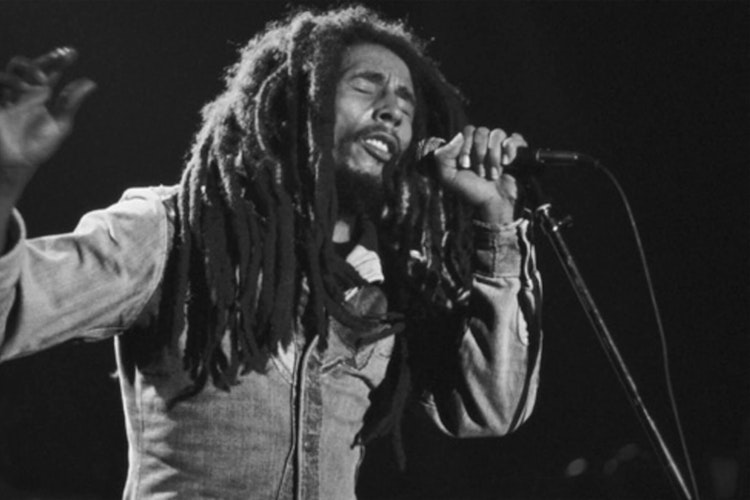In this article, we celebrate Black artists and groups who were influential in shaping both Rock and popular music. These artists and bands started their careers in the early 60s through the late 60s, beginning with Bob Marley and ending with Phil Lynott from Thin Lizzy.
Don’t forget to review all of our other artist lists.
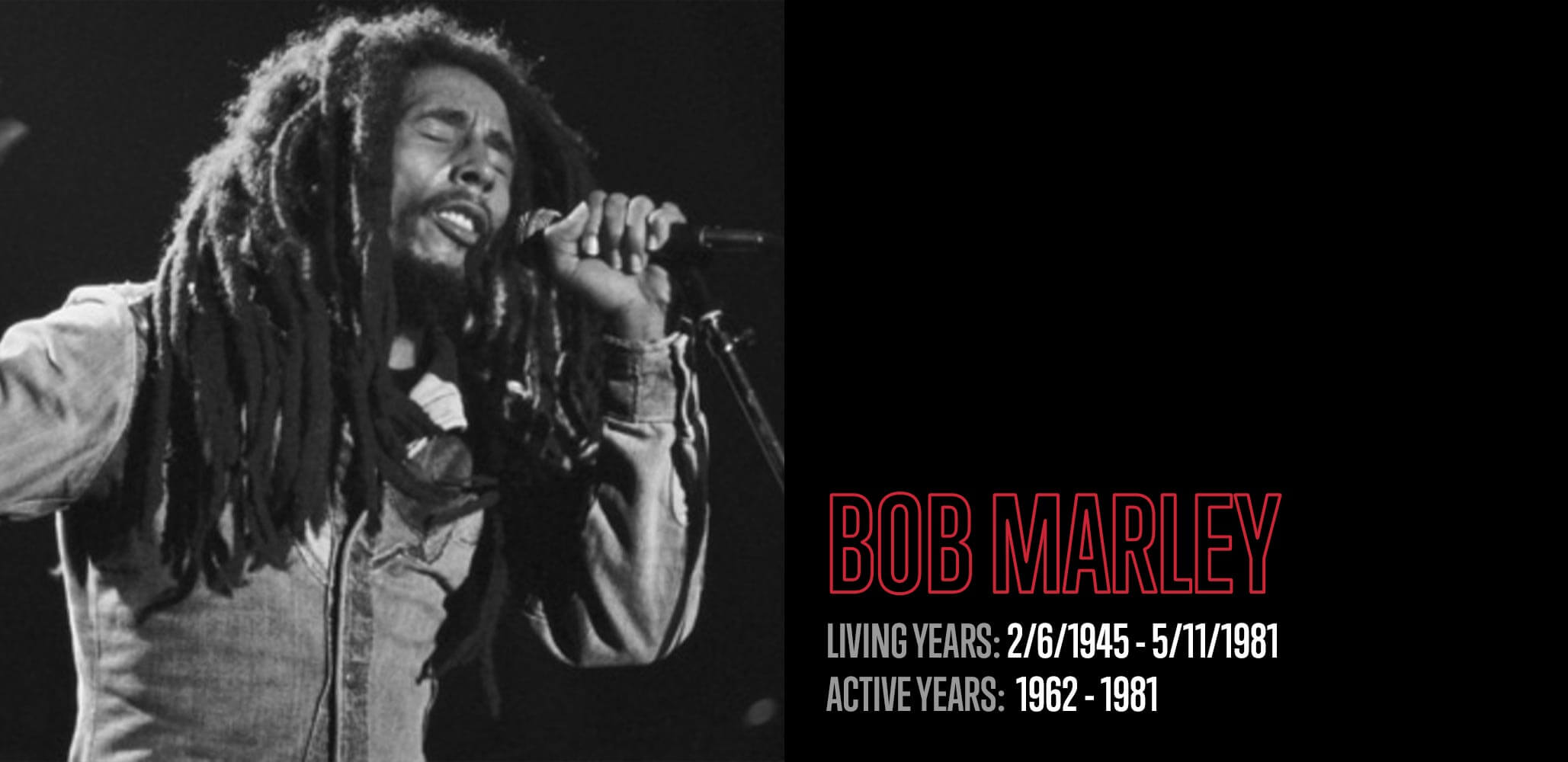
Instruments
Vocals, guitar
Genres
Reggae, Ska, Folk
Notable Songs
No Woman No Cry, Three Little Birds, One Love
Associated Artists/Acts
The Wailers, Peter Tosh, Bunny Wailer, Ziggy Marley, Damian Marley, Skip Marley, Junior Marvin, Jimmy Cliff, Desmond Dekker, Toots and the Maytals, Lee “Scratch” Perry
Biography
Bob Marley was a Jamaican musician and songwriter who pioneered and popularized Reggae music, becoming one of the most celebrated performers in the world.
Marley started playing in bands with friends in the Trenchtown neighborhood of Kinston, Jamaica while in his teens and by age 19 already had a number one hit in Jamaica! Marley, along with Bunny Wailer and Peter Tosh, formed The Wailers in the early 1960s and the band quickly became a popular local Ska act. It wasn’t until 1969 however, that the Wailers, influenced by The Maytals song “Do the Reggay”, joined up with producer Leslie Kong and began to develop the signature sound that would launch them to international stardom. With Kong’s guidance, the band further slowed down Ska and Rocksteady grooves and put a bigger emphasis on Rock and R&B instruments such as electric guitar, organ, and especially bass guitar and drum kit, helping to pioneer the new Reggae sound.
By the early 1970s, when The Wailers signed with Island Records, Reggae music had steadily gained in popularity internationally. In 1973, the band released two albums, Catch a Fire and Burnin’, that became defining examples of the genre, especially after Eric Clapton scored a hit with a cover of Marley’s song “I Shot the Sheriff”, introducing Reggae to wider blues and rock audiences. Bob Marley became the international face of Reggae music and after Bunny Wailer and Peter Tosh went solo, Marley continued to release records under Bob Marley and The Wailers. In 1975, his song “No Woman No Cry” became a worldwide hit and he released seven “solo” studio albums before his untimely death from cancer in 1981 at just 36 years old.
In addition to being an accomplished guitarist, singer and songwriter, Bob Marley was an outspoken political activist and an advocate for human rights. Many of his song lyrics condemn colonialism, imperialism and oppression, and call for unity among African people worldwide. Marley once famously survived an assassination attempt. Although he had been shot multiple times, he performed at a festival just two days later.
Bob Marley is a larger-than-life icon. He is one of the best-selling musical artists of all time and his name is synonymous with the genre he helped create. His musical legacy survives not only through his numerous descendants who have become successful musicians in their own rights, but also through the incalculable influence his songs and Reggae music continue to have on modern Rock, Pop and R&B.
Historical or Cultural Context
Pioneered and popularized Reggae music and was outspoken on a number of political issues from colonialism to oppression
Artists/Acts He Influenced
Jimmy Cliff, The Police, Stevie Wonder, The Clash, Eric Clapton, Madness, Sublime
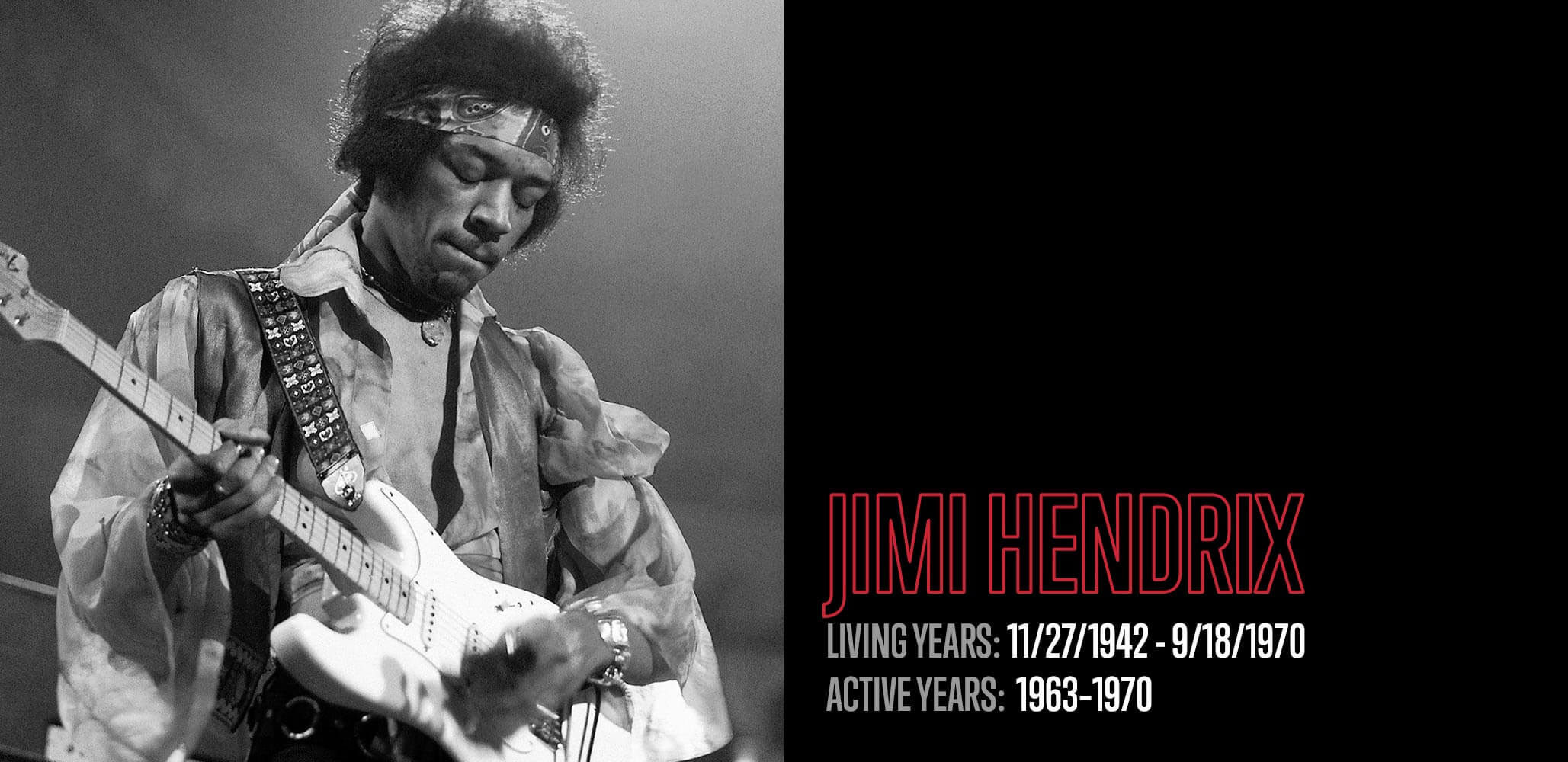
Instruments
Guitar, vocals
Genres
Blues, Ballads, Rock, R&B and Jazz
Notable Songs
Purple Haze, All Along the Watchtower, Little Wing, Voodoo Child (Slight Return), Hey Joe, Machine Gun, Red House
Associated Artists/Acts
The Jimi Hendrix Experience, Little Richard, Billy Cox, Noel Redding, Mitch Mitchell, The Isley Brothers, Band of Gypsys
Biography
Jimi Hendrix was born in Seattle in 1942 and was given the name Johnny Allen Hendrix, but some time later his father (James Allen Hendrix) changed his name to James Marshall Hendrix.
Jimmy (as he was known then) did not learn to read or write music but that did not stop him from becoming a great musician. Instead, he focused on his musical development through auditory perception, having great artists of the time as influences such as Buddy Holly, BB King, Howlin' Wolf, Muddy Waters and Robert Johnson.
Jimmy formed his first band, The Velvetones, in 1958. Shortly after, Jimmy's father bought his first electric guitar (a Supro Ozark 1560 S), which he used in the band The Rocking Kings. In 1961, Jimmy joined the Army and became a paratrooper where he met Billy Cox, a bassist who would become a frequent collaborator. Discharged in 1962, he started to work as a guitarist using the name Jimmy James.
By 1965, Jimmy had established himself as an in-demand sideman and had already played with several famous artists such as Ike and Tina Turner, Little Richard, Sam Cooke and The Isley Brothers. Jimmy formed a new band called Jimmy James and the Blue Flames and caught the ear of bassist Chas Chandler (from the English band The Animals) during one of his performances in Greenwich Village. Chandler invited Hendrix to move to London and form a new band which became the Jimi Hendrix Experience - featuring drummer Mitch Mitchell, bassist Noel Redding, and "Jimi" with his new stage name, styled by Chas Chandler.
The band’s first single “Hey Joe” and the resulting album Are You Experienced, released in 1967, were immediate successes in England. In June 1967, Jimi returned to America and, after his show-stealing performance at the Monterey Pop Festival where he famously lit his guitar on fire, The Jimi Hendrix Experience became one of the highest grossing touring acts in the world. At the end of 1967, Hendrix released Axis: Bold As Love, a landmark album that saw him expand on his unique style with innovative studio techniques and experimental guitar and vocal effects.
In 1968, The Jimi Hendrix Experience released their final album, Electric Ladyland. The album contained a revolutionary cover of Bob Dylan’s “All Along the Watchtower,” which so influenced Dylan that he began to borrow from Hendrix’s arrangement in concert. The song became Hendrix’s highest-charting single. However, despite the band’s success, tensions between Hendrix, the musicians and manager Chandler became too difficult to work through and The Experience disbanded in 1969.
Hendrix continued working as a solo artist and performed at Woodstock with a new band (which he named Gypsy Sun and Rainbows). His feedback-drenched guitar performance of the United States’ National Anthem (“Star Spangled Banner”) at Woodstock has become one of the most memorable moments in Rock and Roll history and was a landmark action of protest by Rock’s most influential Black musician.
After Woodstock, Hendrix reunited with old Army buddy Billy Cox, and along with drummer Buddy Miles, formed Band of Gypsys, an all-Black trio that brought more Soul, Funk and Jazz influence to Hendrix’s always innovative guitar playing. Hendrix recorded one album with this band, titled Band of Gypsys. The album is notable for its extensive improvisational jams and for Hendrix’s song “Machine Gun”, a Vietnam War protest song where Hendrix creates a sonic environment of war with his guitar, simulating gunfire and rockets.
In 1970, Jimi reunited members of The Jimi Hendrix Experience and recorded several tracks in the studio for an album that was supposed to be called First Rays Of The New Rising Sun. Sadly, Jimi died on September 18, 1970, from an accidental overdose of painkillers. He was only 27 years old. His final album - eventually titled The Cry of Love - was released in 1971, curated by studio engineer Eddie Kramer and drummer Mitch Mitchell. Later posthumous Hendrix releases include Voodoo Soup in 1995 and First Rays of the New Rising Sun in 1997.
Jimi Hendrix was one of the most influential and creative musicians of the 20th century and modern ideas about playing guitar in Rock music would never have been the same without him. He has been credited as a major inspiration by legions of pro players, including Eric Clapton, Jeff Beck, Jimmy Page, Eddie Van Halen, Prince, Slash, Steve Vai, Joe Satriani, Stevie Ray Vaughan, Eddie Hazel, John Frusciante, Gary Clark Jr., John Mayer, Tom Morello and hundreds more. Hendrix, along with the other members of the Experience, was inducted into the Rock and Roll Hall of Fame in 1992. He was awarded a Grammy Lifetime Achievement Award the same year. In 2014, the United States Postal Service issued a commemorative stamp in honor of Jimi Hendrix’s contributions to American culture and music.
Technical Innovations
Innovator of guitar tones and sonic textures; pioneer of distortion, feedback, wah, phaser, and other effects
Historical or Cultural Context
Widely considered to be the greatest guitar player in Rock history and much of his music was influenced by politics such as the Vietnam War
Artists/Acts They Influenced
Steve Vai, Slash, Prince, Eric Clapton, David Bowie, Freddie Mercury, Michael Hampton (Parliament-Funkadelic), Stevie Ray Vaughan, Joe Satriani, Jeff Beck, Jimmy Page, Eddie Van Halen, John Frusciante, Gary Clark Jr., John Mayer, Tom Morello, and many others
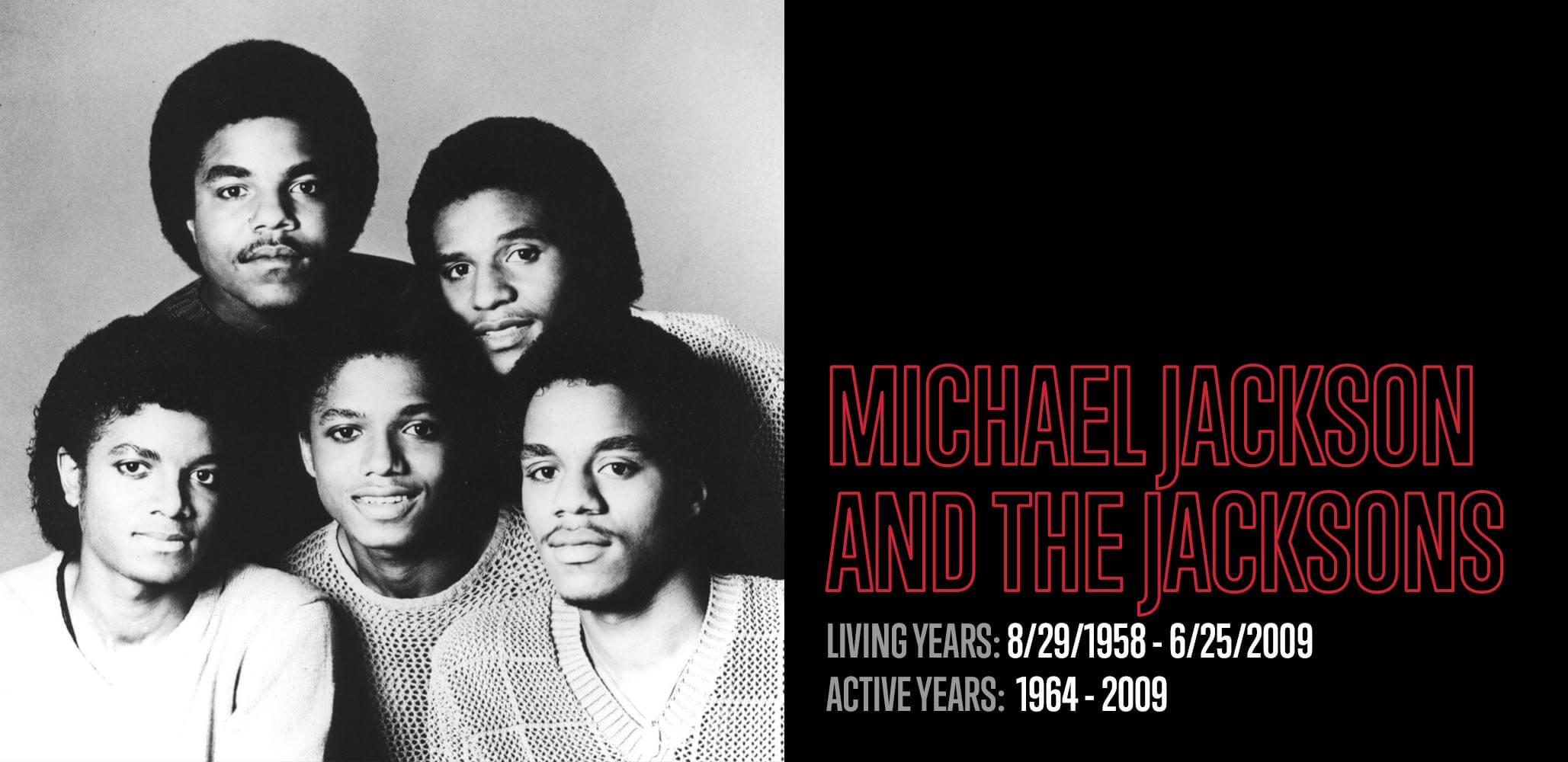
Instruments
Vocals, keys, drums, guitar, percussion, bass
Genres
Pop, Funk, Disco, R&B
Notable Songs
I Want You Back, ABC, Beat it, Billie Jean
Associated Artists/Acts
Michael Jackson, Janet Jackson, Jermaine Jackson, The Jacksons, The Jackson 5
Biography
When Michael Jackson joined his older brothers in the Jackson Brothers in 1964, the course of Pop and R&B music was changed forever. Michael was six years old when he joined his older brothers Jackie, Tito, Jermaine and Marlon, and soon they were the Jackson 5. Their father Joe Jackson was a taskmaster and booked the boys all over the Midwest and East Coast. In 1967, the Jackson 5 signed with a small local label, Steeltown Records, and released a few singles with limited success.
They signed with Motown Records in 1968 and the label put their resources behind the band. Their first single, “I Want You Back,” went to Number One and they followed with three more consecutive Number One singles; “ABC”, “The Love You Save,” and “I’ll Be There”. They released four albums from 1970-71 with three of the albums coming out in 1970. The Jackson 5 became Motown’s best-selling act and the blueprint for future generations of Boy Bands.
The Jackson 5 frequently appeared on network television and on the covers of teen magazines. Michael began releasing solo material in 1971. The band’s success started to slow down in the mid-70s just as Michael’s solo career was taking off. Their relationship with Motown soured and the band moved to Epic Records in 1976. As Motown owned the rights to the Jackson 5 name, the band became “The Jacksons”.
While The Jacksons had a substantial hit with the album Destiny in 1978, Michael released Off the Wall in 1979. Off the Wall was the album that marked Michael’s emergence as a serious solo performer. It's also Michael’s first album produced by Quincy Jones. The album was incredibly successful, selling over 20 million copies internationally. However, Michael still remained part of the Jacksons, releasing the album Triumph.
Michael’s tour de force Thriller was released in 1982, ushering in one of the most successful periods of the record industry. Bolstered by MTV, “Thriller” featured an extended 14-minute long-form video featuring choreographed zombies and Jackson’s amazing dance skills. Where most albums contained one or two hits, Thriller had seven Top Ten singles and won eight Grammy awards. It is the best selling record of all time with over 66 million copies sold.
After the unparalleled success of Thriller, Michael continued for one more record with the Jacksons - Victory. After touring for the album, Michael left the Jacksons. Over the next few years, Michael’s success and notoriety became tabloid fodder with reports of him being treated for a variety of medical conditions and undergoing extensive plastic surgery. In 1987, he released Bad and continued to top the charts. Jackson was now known as the King of Pop, a title that placed him on top of the music world, following in the footsteps of Elvis and the Beatles. This is significant because no other Black entertainer has achieved this level of popular success.
In the '90s, Jackson continued to release albums including Dangerous, which contained the chart-topping single “Black or White”. Michael purchased Neverland Ranch, his personal estate which resembled an amusement park. Neverland was named after the fictional island in the Peter Pan story. Jackson released his autobiography Moonwalk where he disclosed abuse at the hands of his father and a lonely childhood. During this period, allegations arose around Jackson’s alleged improper relationships with children. Despite the allegations, Jackson was never found guilty of any criminal offenses.
During the 2000s, Jackson remained in the spotlight but his musical career continued to be upstaged by his personal life. He endured financial struggles and in late 2003, more criminal charges were filed against Jackson. After a lengthy trial in 2005, Jackson was again acquitted on all counts. Jackson continued to have health and financial problems.
In 2009, Jackson announced a series of comeback shows titled This Is It. During rehearsals for the upcoming shows, Jackson died of an overdose of propofol on June 25th. His untimely death was ruled a homicide and his personal physician was convicted of Involuntary Manslaughter. After his death, there were more allegations of child abuse and the HBO documnetary Leaving Neverland was released. The documentary fueled support from fans as well as a backlash against Jackson.
Influenced by James Brown, Little Richard, and close friend Diana Ross, Michael Jackson is perhaps the biggest musical star of all time. From child prodigy to the most successful entertainer in history, Jackson left a musical legacy unrivaled in its brilliance and controversy.
Technical Innovations
Revolutionized video production
Historical or Cultural Context
Biggest Pop star of all time, the King Of Pop
Artists/Acts He Influenced
Prince, Boyz II Men, NSYNC, Backstreet Boys, Justin Bieber, The Weeknd, and countless others
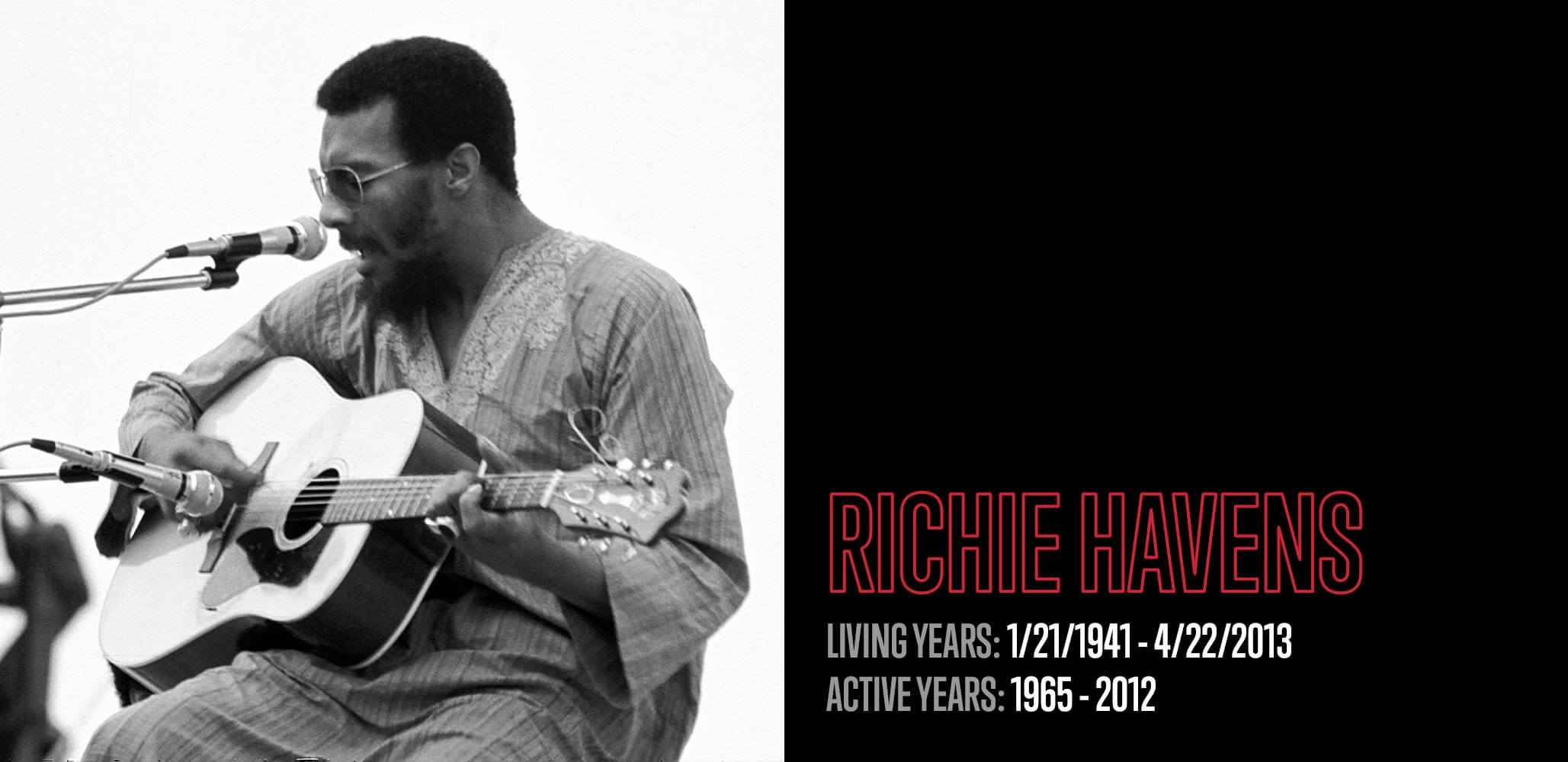
Instruments
Vocals, guitar
Genres
Folk, Blues, Soul
Notable Songs
Associated Artists/Acts
Bob Dylan, The Beatles
Biography
Richie Havens grew up in Brooklyn and moved to Greenwich Village in the 1960s, where in his early twenties he established himself in that neighborhood’s growing Folk music scene. Havens’ aggressively percussive guitar style and his soulful voice garnered attention in Folk circles and beyond and his 1968 album Something Else Again broke into the Billboard Top 200. At the Woodstock festival in 1969, Havens drew national attention with a captivating opening set that included an improvised arrangement of what later became his signature song, “Freedom”, based on the old African-American spiritual “Motherless Child”. Ironically, he opened the festival by happenstance; the scheduled opening act (the band Sweetwater) was late due to traffic, and Havens, who ran out of prepared material, improvised “Freedom” to extend his set until Sweetwater arrived.
After Woodstock, Havens was an international star and a major influence on Folk, Blues and Rock music. He had a gift for reinterpreting popular Rock songs in his own unique style. His version of The Beatles’ “Here Comes the Sun” was his most commercially successful single. In turn, his own songs were covered by popular Rock bands such as “No Opportunity Necessary, No Experience Needed” which was covered by the Prog band Yes.
Richie Havens was also an accomplished actor, appearing in numerous movies and in the original stage adaptation of The Who’s Tommy. In the 1980s, he became a leading writer and performer of commercial jingles. Havens, who was of Native American and African descent, was an advocate for Native American and Indigenous People’s rights. He was also passionate about the environment and created programs that educated children on environmental issues.
Havens toured and performed regularly for 45 years, from clubs, to major festivals like Woodstock and the Tibetan Freedom Concert, to Bill Clinton’s presidential inauguration. Health issues led to his retirement from touring in 2010 and he died of a heart attack in 2013.
Historical or Cultural Context
Folk Rock pioneer, Woodstock icon, advocate for Native American and Indigenous People’s rights
Artists/Acts He Influenced
Bob Dylan, The Beatles, The Who, Yes, Flaming Lips
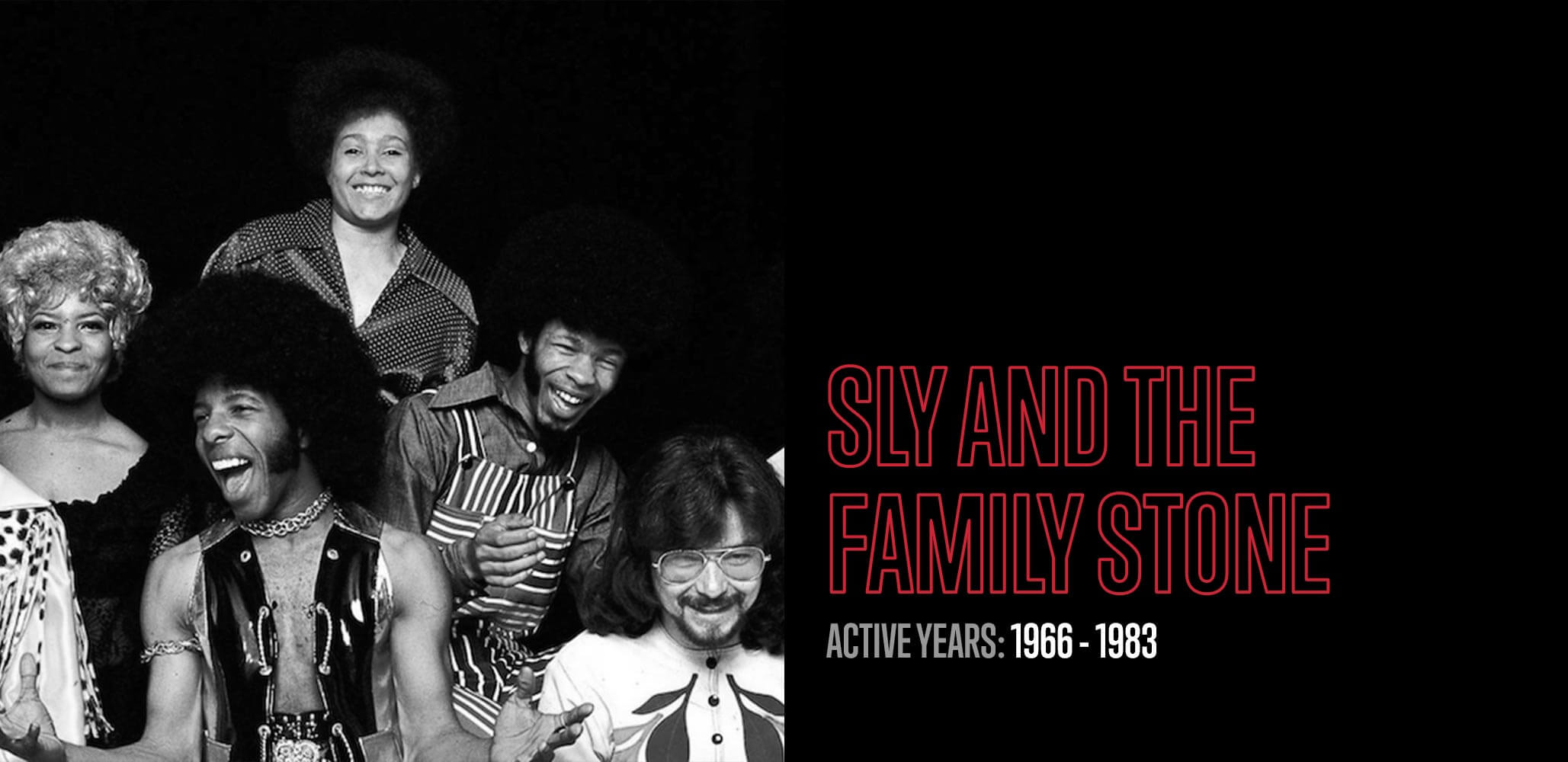
Instruments
Sly Stone (vocals and keys), Freddi Stone (guitar and vocals), Rose Stone (keys and vocals), Larry Graham (bass), Jerry Martini (sax), Cynthia Robinson (trumpet), and Greg Errico (drums)
Genres
Funk, Rock, Soul, Psychedelic
Notable Songs
Dance to the Music, Everyday People, Thank You (Falettinme Be Mice Elf Again), If You Want Me To Stay
Associated Artists/Acts
Graham Central Station
Biography
Sly and the Family Stone were a Funk, Rock, Soul and Psychedelic band formed in San Francisco in 1966. Led by the charismatic Sly Stone, they were highly successful and were the first prominent Rock band to feature a multi-racial lineup as well as men and women in the band.
Sylvester “Sly” Stone wrote and produced the band’s material. A gifted musician, Sly was a child prodigy who grew up playing Gospel music. Integrated bands were a rarity outside of Jazz and the band presented a visual message that matched their positive lyrical message of human connection.
The band’s classic lineup consisted of Sly on vocals and keys and his siblings Freddi Stone (guitar and vocals) and Rose Stone (keys and vocals). Their bassist Larry Graham is the inventor of the slap bass technique, a sound that helped define modern Funk. The horn section consisted of Cynthia Robinson and Jerry Martini, who happened to be the cousin of drummer Greg Errico.
Sly and the Family Stone first topped the charts with the single “Dance to the Music” in 1968 from their second album of the same name. This led to a string of hits including “Everyday People” and “Thank You (Falettinme Be Mice Elf Again)”. The band cranked out albums until 1982 but their last major hit was in 1973 with “If You Want Me To Stay”.
In 1969, the band played Woodstock. Their performance ranks as a highlight of the festival alongside Jimi Hendrix and The Who. Unfortunately, the band’s success was causing internal friction and the band members gained a reputation for being unreliable due to their drug use, especially Sly. In 1971, Errico was the first to leave, followed by Graham and Freddie Stone who formed Graham Central Station in 1973.
Sly Stone fell on hard times after the band broke up. The band was inducted into the Rock and Roll Hall of Fame in 1993, and that was Stone’s last public appearance until 2006. In 2010, Stone sued his former manager and was awarded five million dollars, only to have that decision later overturned. Although they are often overlooked by modern music fans, Sly and the Family Stone were ahead of their time musically and are one of the most influential Funk bands of all time, influencing everyone from Prince to the Red Hot Chili Peppers to the Beastie Boys.
Historical or Cultural Context
First major Rock band to feature a multi-racial and mixed gender lineup
Artists/Acts They Influenced
Prince, Red Hot Chili Peppers, Dirtbombs, Beastie Boys
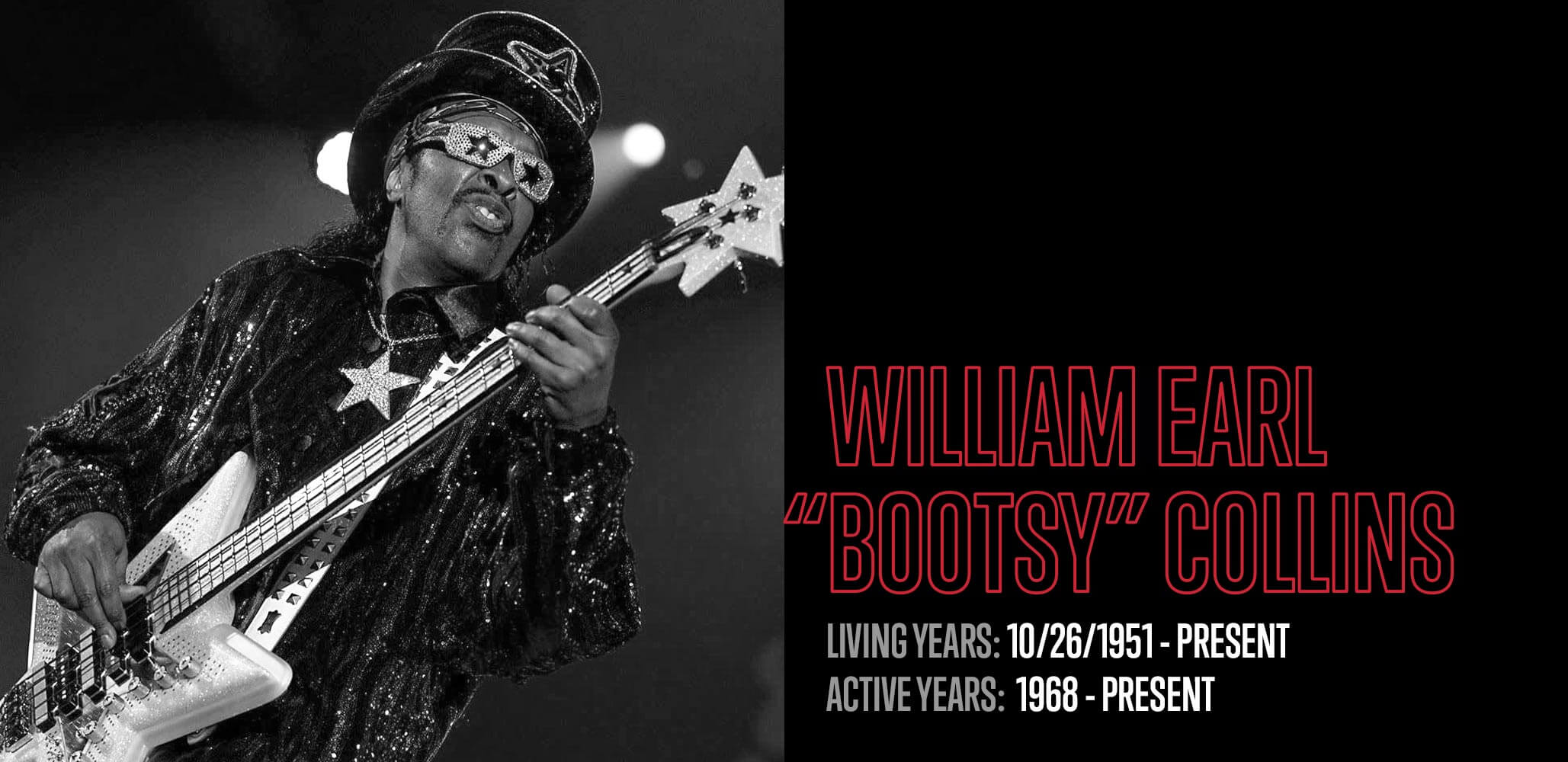
Instruments
Bass, vocals
Genres
Funk, Soul, Rock, R&B
Notable Songs
Super Bad (James Brown), Flash Light (Parliament), Groove Is In The Heart (Deee-Lite)
Associated Artists/Acts
Parliament-Funkadelic, Bootsy's Rubber Band, James Brown, The J.B.'s, George Clinton, Deee-Lite, Catfish Collins, Fatboy Slim, Buddy Miles, Clyde Stubblefield
Biography
Bootsy Collins is one of the most well-known, widely-respected, and influential bass players in the history of American music and is one of the pioneers of Funk music. Born in Cincinnati, Collins was just 19 years old when he, along with his guitarist brother Catfish Collins and some other bandmates, were hired as the backing band for Soul and Funk legend James Brown. Known as the J.B.’s, this band would back James Brown on many hard-driving Funk hits such as “Get Up (I Feel Like Being a) Sex Machine” and “Super Bad”.
After leaving the J.B.’s in the early 1970s, Bootsy Collins hooked up with George Clinton in Funkadelic where he was able to further develop his funky bass style, his songwriting chops, and his flamboyant personal style (including his signature “Space Bass”). Collins’ style helped define the parameters of Funk bass lines - heavy emphasis on the “1”, use of slap and pop technique, and experimentation with effects like wah and envelope filter. Even during his time in Funkadelic and its offshoot Parliament, the prolific Collins released numerous successful albums with his side project Bootsy’s Rubber Band.
In the 1980s and 1990s, Bootsy Collins continued performing, producing, and collaborating with many artists, branching into the electronic Club Dance genre - notably partnering with Deee-Lite on their smash hit “Groove Is In The Heart”. He was inducted into the Rock and Roll Hall of Fame in 1997 as a member of Parliament-Funkadelic. Although he is now retired from performing, Bootsy Collins has become a philanthropist and an advocate for youth music education and remains one of the most influential bass players and personalities in Rock and Roll history.
Technical Innovations
Space Bass
Historical or Cultural Context
Funk pioneer, legendary bass player, advocate for youth music education
Artists/Acts He Influenced
Prince, Flea, Rick James, Les Claypool, Thundercat, Childish Gambino
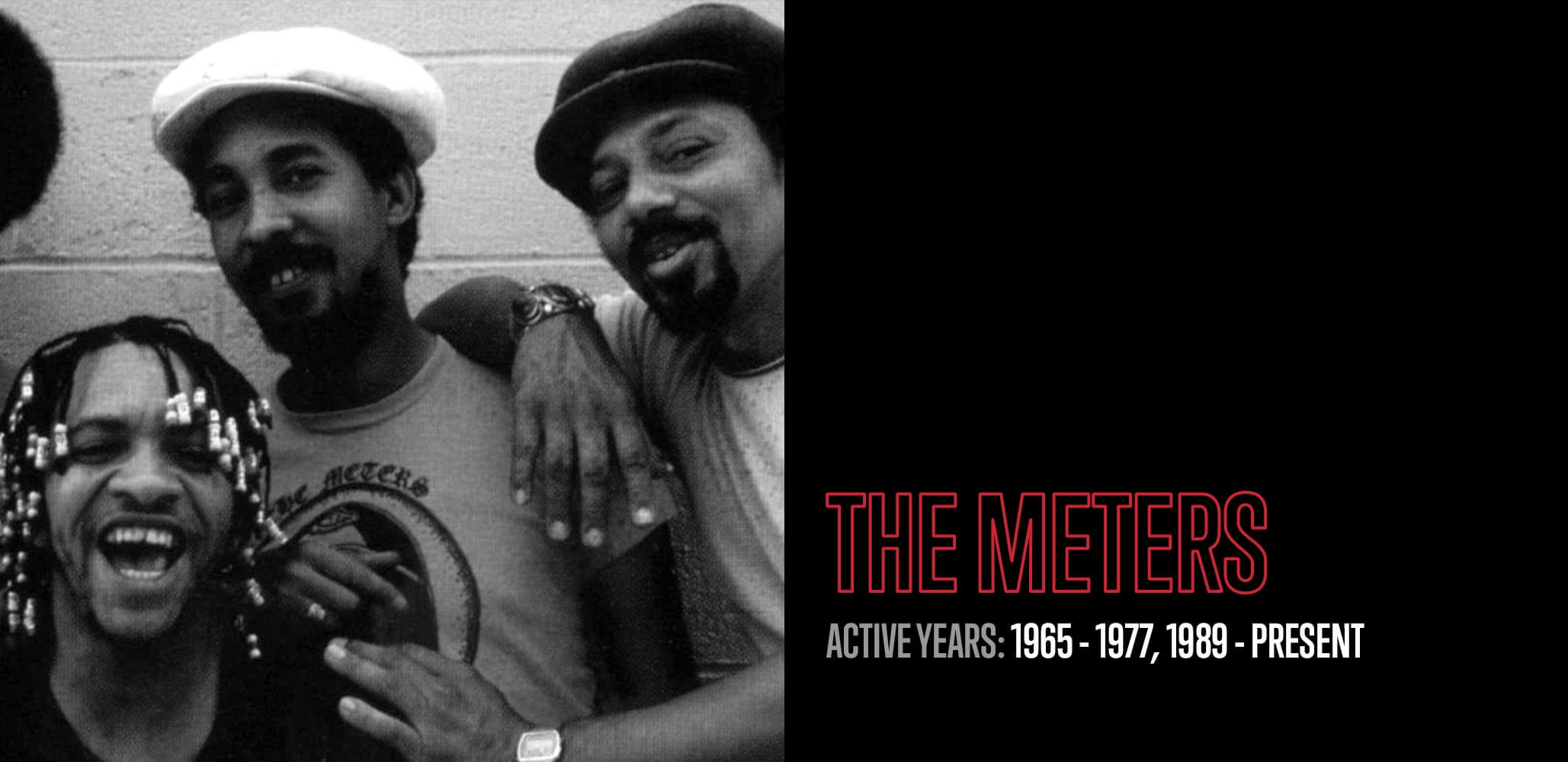
Genres
Funk, Soul
Notable Songs
Associated Artists/Acts
Funky Meters, Neville Brothers
Biography
The Meters were formed in 1965 in New Orleans with Art Neville (keys and vocals), George Porter Jr. (bass), Leo Nocentelli (guitar), and Zigaboo Modeliste (drums). Cyril Neville (percussion and vocals) was also part of the band in the 70s. Originally the main studio musicians at Allen Toussaint's record label Sansu, the band found success with the influential single “Cissy Strut” in 1969.
The Meters’ sound defines New Orleans Funk. The Meters provided backing for several other artists’ hits such as Labelle’s “Lady Marmalade” and Dr. John’s “Right Place, Wrong Time”. Their syncopated grooves combined with Toussaint’s spare but tight production have been sampled by hundreds of Hip Hop artists including Run DMC, NWA, Ice Cube, Public Enemy, and Beastie Boys. The Meters’ tight, funky grooves have inspired countless bands as diverse as Led Zeppelin and the Talking Heads.
The Meters took a hiatus from 1980-1989. The band had several lineup changes and performed as The Funky Meters. In 2000, the original members reunited for a gig. Since then, the band has been either billed as the Original Meters or the Funky Meters depending on the lineup. The final Original Meters show was in 2017. Art Neville retired from the music business in 2018 and passed away on July 22, 2019. Various members of the Meters perform in a variety of configurations and remain extremely popular, especially on the Jam Band festival circuit where they have influenced a new generation of artists.
Historical or Cultural Context
Creators of New Orleans Funk
Artists/Acts They Influenced
Red Hot Chili Peppers, Keith Richards, Grateful Dead, Galactic, Phish
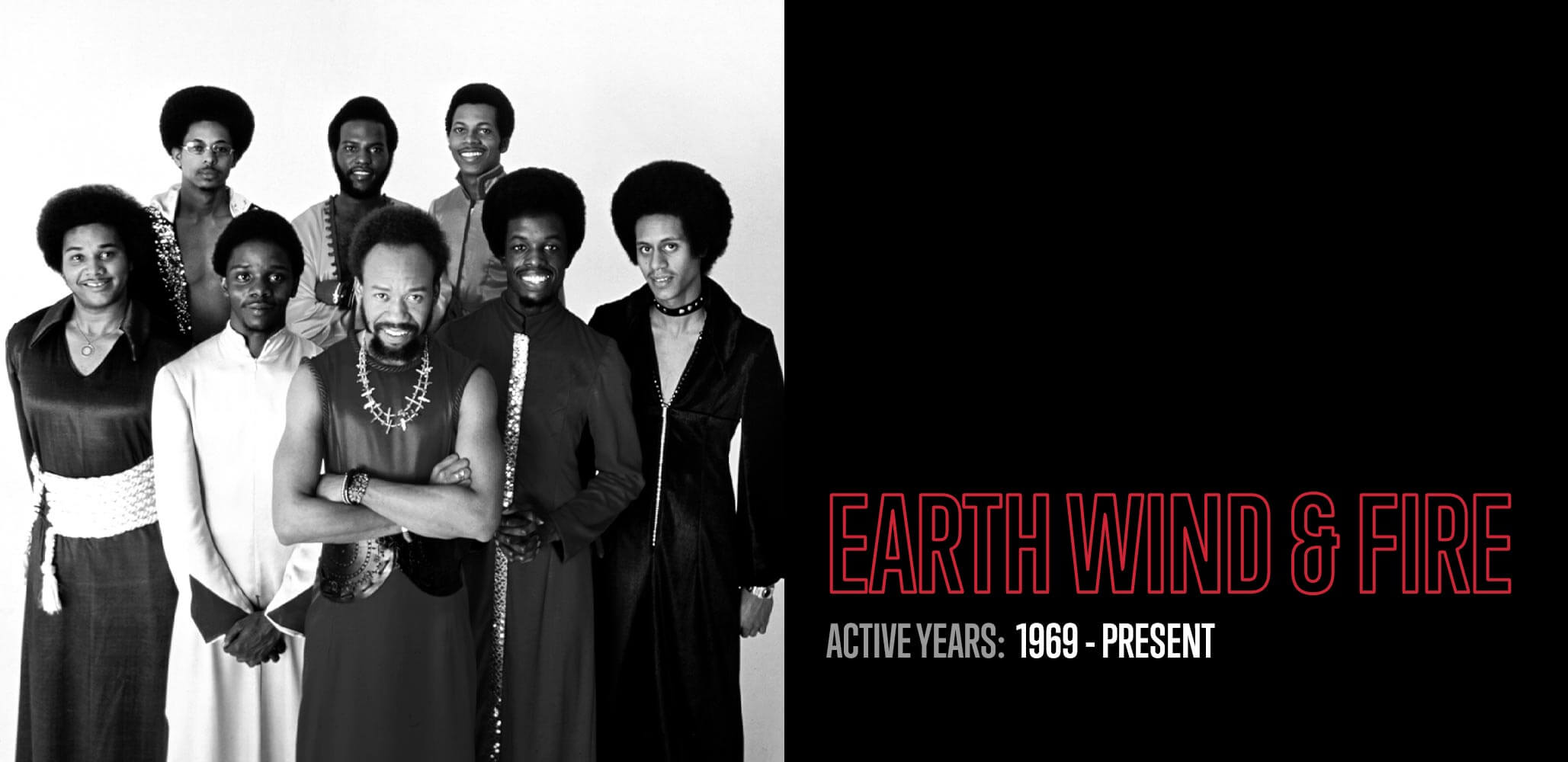
Genres
R&B, Soul, Funk, Disco, Rock
Notable Songs
September, After The Love Is Gone, Shining Star, Let’s Groove
Biography
Earth, Wind & Fire (often shortened to EWF) is an R&B band from Chicago that blended elements of Soul, Funk, Disco, Rock, Jazz, World Music, and Electronica into a unique sound that made them one of the most successful bands in American music history. The band was founded by Maurice White in 1969 and has featured a large ensemble of supporting musicians including vocalist Phillip Bailey and Maurice’s half-brother, bassist Verdine White. EWF is known for their danceable Pop anthems, their diverse instrumentation (including a large horn section and Maurice White’s talents on kalimba), and their elaborate stage productions. White’s baritone voice and Bailey’s signature falsetto create a dynamic contrast that gives many EWF songs an instantly recognizable sound.
With hit songs like “Shining Star” and “September”, EWF established themselves in the 1970s as the pre-eminent R&B band in the world. They have sold over 90 million albums, and in one stretch from 1975-1981 they released six consecutive Top 10 albums, four of which hit number one on the R&B charts. Throughout the 1980s, EWF continued to find success and embraced musical technology and electronic experimentation on hits like “Let’s Groove”.
Earth, Wind & Fire were celebrated for their groundbreaking and elaborate stage productions featuring costumes, set pieces, choreography, pyrotechnics, and even optical illusions such as a floating piano! Maurice White believed that music should be an avenue for positivity and strived to create a magical atmosphere at the band’s performances.
Despite a brief hiatus during the 1980’s, EWF remained an international stage attraction well into the 21st century. The band was inducted into the Rock and Roll Hall of Fame in 2000. Maurice White passed away on February 4, 2016 after suffering from Parkinson’s disease. That same year, Earth Wind & Fire received the Lifetime Achievement Award at the 2016 Grammys. In 2019, Earth, Wind & Fire became the first African American band to receive Kennedy Center Honors.
Artists/Acts They Influenced
Lenny Kravitz, Linkin Park, Erykah Badu, Fallout Boy, Amy Winehouse
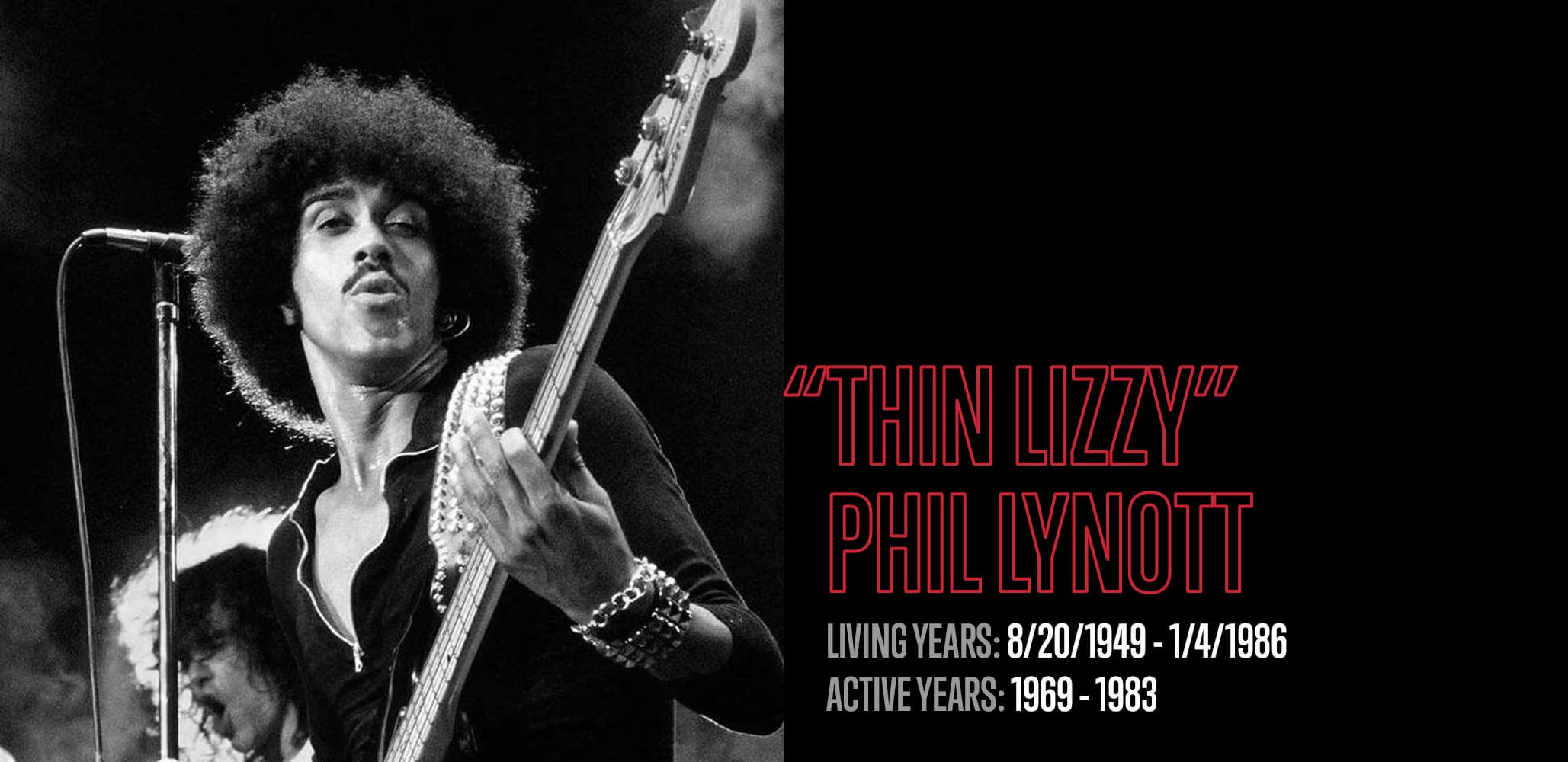
Instruments
Vocals, bass
Genres
Rock, Hard Rock, Traditional Irish
Notable Songs
The Boys are Back in Town, Whiskey in the Jar, Cowboy Song
Biography
Phil Lynott is truly one of the unsung heroes of Rock and Roll. Fronting seminal Hard Rock band Thin Lizzy (while also playing bass) made Phil Lynott Ireland’s first Black rock star. Born in England in 1949, Phil grew up in Ireland and was raised by his grandparents. After singing in a succession of bands (including Skid Row with future Thin Lizzy guitarist Gary Moore), Lynott and drummer Brian Downey formed Thin Lizzy in 1969.
Thin Lizzy were known for their twin harmony guitars and Lynott’s ultra-cool onstage persona. As the band’s chief songwriter, vocalist, and bassist, Lynott was not only the face but the creative force behind the band. They first had a hit in Ireland with the traditional “Whiskey in the Jar” in 1973 and then produced a worldwide smash hit with “The Boys are Back in Town” in 1976. Other stand out tracks include “Jailbreak” and “Cowboy Song”.
Lynott’s introspective lyrics were more in the vein of Bob Dylan than the typical hard rocker. He often used Irish themes which further cemented his place in Irish Rock history and culture. Lynott had a unique, laid back vocal delivery that added to the story telling quality of the songs. Thin Lizzy were huge influences on a slew of Metal and Hard Rock bands including Metallica and Def Leppard. After struggling with addiction, Lynott was hospitalized and died in 1986 at the age of 36. Thin Lizzy were nominated to the Rock and Roll Hall of Fame in 2020, but failed to be inducted.
Historical or Cultural Context
First successful Black Irish Rock musician
Artists/Acts They Influenced
Metallica, Iron Maiden, Def Leppard
This article was last updated in September, 2020.




